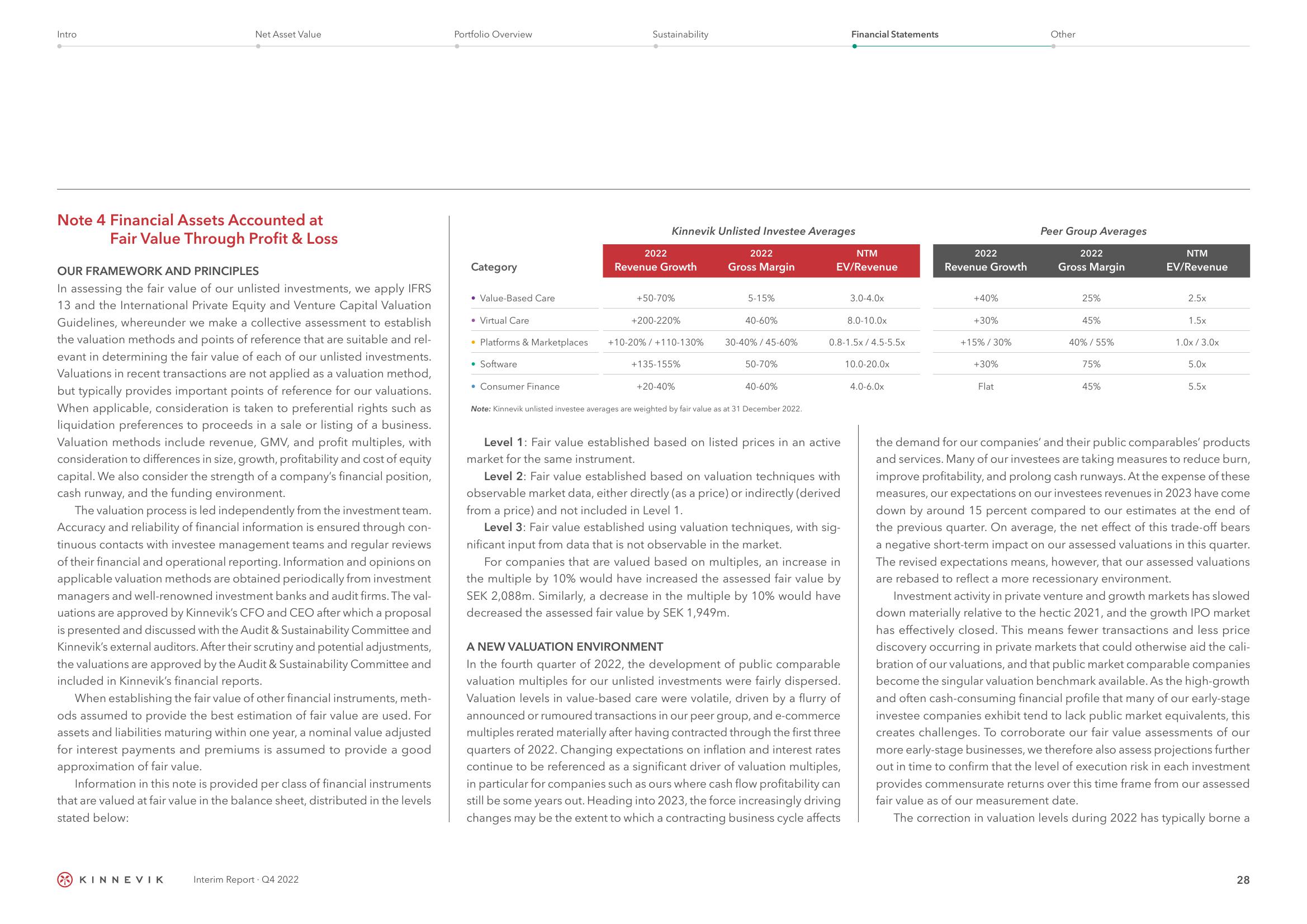Kinnevik Results Presentation Deck
Intro
Net Asset Value
Note 4 Financial Assets Accounted at
Fair Value Through Profit & Loss
OUR FRAMEWORK AND PRINCIPLES
In assessing the fair value of our unlisted investments, we apply IFRS
13 and the International Private Equity and Venture Capital Valuation
Guidelines, whereunder we make a collective assessment to establish
the valuation methods and points of reference that are suitable and rel-
evant in determining the fair value of each of our unlisted investments.
Valuations in recent transactions are not applied as a valuation method,
but typically provides important points of reference for our valuations.
When applicable, consideration is taken to preferential rights such as
liquidation preferences to proceeds in a sale or listing of a business.
Valuation methods include revenue, GMV, and profit multiples, with
consideration to differences in size, growth, profitability and cost of equity
capital. We also consider the strength of a company's financial position,
cash runway, and the funding environment.
The valuation process is led independently from the investment team.
Accuracy and reliability of financial information is ensured through con-
tinuous contacts with investee management teams and regular reviews
of their financial and operational reporting. Information and opinions on
applicable valuation methods are obtained periodically from investment
managers and well-renowned investment banks and audit firms. The val-
uations are approved by Kinnevik's CFO and CEO after which a proposal
is presented and discussed with the Audit & Sustainability Committee and
Kinnevik's external auditors. After their scrutiny and potential adjustments,
the valuations are approved by the Audit & Sustainability Committee and
included in Kinnevik's financial reports.
When establishing the fair value of other financial instruments, meth-
ods assumed to provide the best estimation of fair value are used. For
assets and liabilities maturing within one year, a nominal value adjusted
for interest payments and premiums is assumed to provide a good
approximation of fair value.
Information in this note is provided per class of financial instruments
that are valued at fair value in the balance sheet, distributed in the levels
stated below:
KINNEVIK
Interim Report Q4 2022
Portfolio Overview
Category
• Value-Based Care
• Virtual Care
• Platforms & Marketplaces
• Software
• Consumer Finance
Sustainability
2022
Kinnevik Unlisted Investee Averages
Revenue Growth
+50-70%
+200-220%
+10-20%/ +110-130%
+135-155%
+20-40%
2022
Gross Margin
5-15%
40-60%
30-40% / 45-60%
50-70%
40-60%
Note: Kinnevik unlisted investee averages are weighted by fair value as at 31 December 2022.
Financial Statements
NTM
EV/Revenue
Level 1: Fair value established based on listed prices in an active
market for the same instrument.
Level 2: Fair value established based on valuation techniques with
observable market data, either directly (as a price) or indirectly (derived
from a price) and not included in Level 1.
Level 3: Fair value established using valuation techniques, with sig-
nificant input from data that is not observable in the market.
For companies that are valued based on multiples, an increase in
the multiple by 10% would have increased the assessed fair value by
SEK 2,088m. Similarly, a decrease in the multiple by 10% would have
decreased the assessed fair value by SEK 1,949m.
A NEW VALUATION ENVIRONMENT
In the fourth quarter of 2022, the development of public comparable
valuation multiples for our unlisted investments were fairly dispersed.
Valuation levels in value-based care were volatile, driven by a flurry of
announced or rumoured transactions in our peer group, and e-commerce
multiples rerated materially after having contracted through the first three
quarters of 2022. Changing expectations on inflation and interest rates
continue to be referenced as a significant driver of valuation multiples,
in particular for companies such as ours where cash flow profitability can
still be some years out. Heading into 2023, the force increasingly driving
changes may be the extent to which a contracting business cycle affects
3.0-4.0x
0.8-1.5x / 4.5-5.5x
8.0-10.0x
10.0-20.0x
4.0-6.0x
2022
Revenue Growth
+40%
+30%
+15% / 30%
+30%
Flat
Other
Peer Group Averages
2022
Gross Margin
25%
45%
40% / 55%
75%
45%
NTM
EV/Revenue
2.5x
1.5x
1.0x/3.0x
5.0x
5.5x
the demand for our companies' and their public comparables' products
and services. Many of our investees are taking measures to reduce burn,
improve profitability, and prolong cash runways. At the expense of these
measures, our expectations on our investees revenues in 2023 have come
down by around 15 percent compared to our estimates at the end of
the previous quarter. On average, the net effect of this trade-off bears
a negative short-term impact on our assessed valuations
this quarter.
The revised expectations means, however, that our assessed valuations
are rebased to reflect a more recessionary environment.
Investment activity in private venture and growth markets has slowed
down materially relative to the hectic 2021, and the growth IPO market
has effectively closed. This means fewer transactions and less price
discovery occurring in private markets that could otherwise aid the cali-
bration of our valuations, and that public market comparable companies
become the singular valuation benchmark available. As the high-growth
and often cash-consuming financial profile that many of our early-stage
investee companies exhibit tend to lack public market equivalents, this
creates challenges. To corroborate our fair value assessments of our
more early-stage businesses, we therefore also assess projections further
out in time to confirm that the level of execution risk in each investment
provides commensurate returns over this time frame from our assessed
fair value as of our measurement date.
The correction in valuation levels during 2022 has typically borne a
28View entire presentation